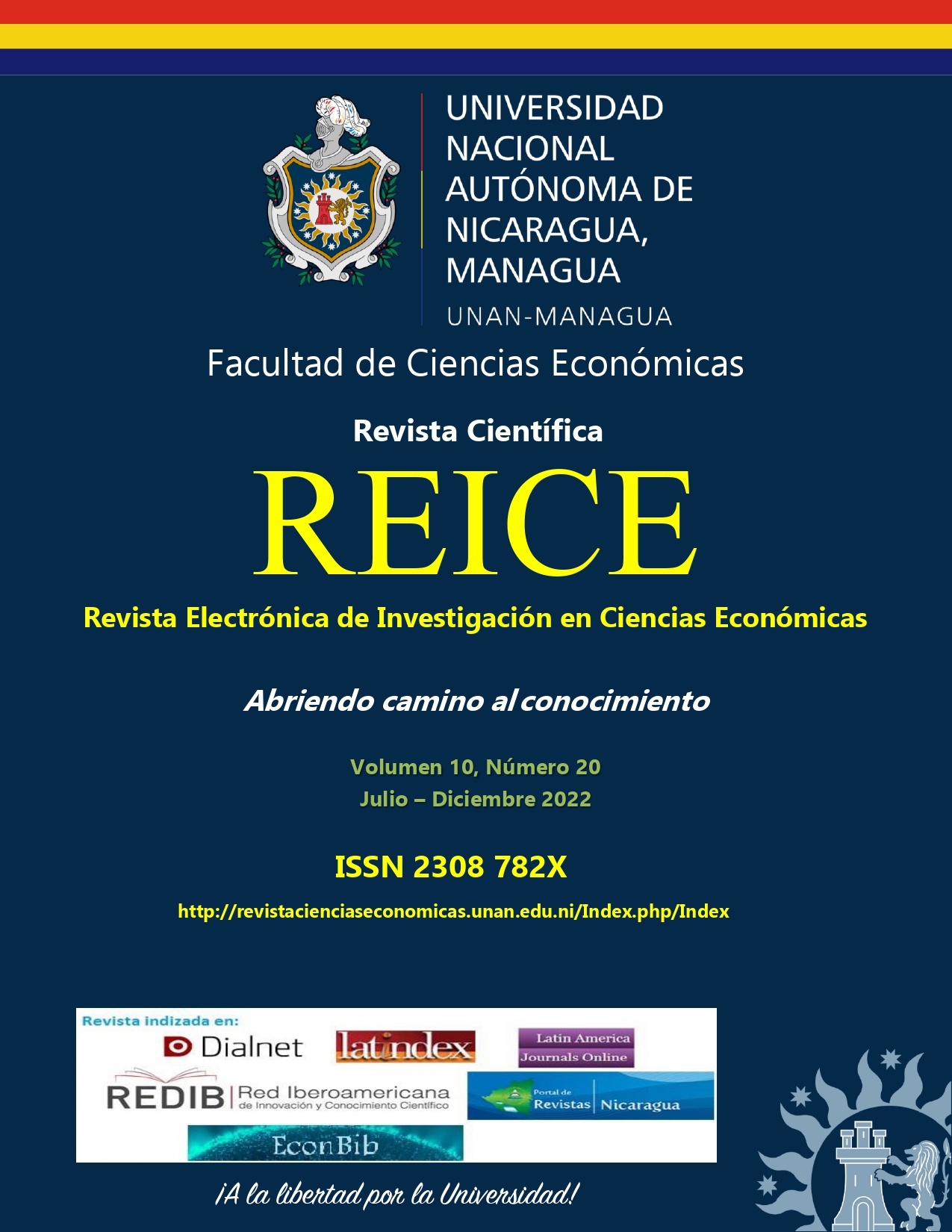Testing the Financial Convergence Hypothesis and Estimating the Convergence Rate in Selected Countries
DOI:
https://doi.org/10.5377/reice.v10i20.16024Keywords:
Convergence, Financial Deepening, Capital Account, Dynamic PanelAbstract
The hypothesis of financial convergence as one of the results of neoclassical economic growth models, emphasizes the process of reducing the financial gap between countries. The main purpose of this study is to test the financial convergence hypothesis and estimate the convergence rate in selected developed and developing countries by using GMM during the period 2018-1990. Results According to both of two models, the domestic credit to the private sector (percentage of GDP) and the current money to GDP approved the financial convergence in these countries. Also, the convergence rate in term of domestic credit to the private sector in developing countries is higher than that’s in developed countries. However, Convergence rate in term of current money to GDP between the two groups of developing and developed countries is very small and about 1%.
Downloads
262
References
Arellano, M, Bond S, 1991. Some Tests of Specification for Panel Data: Monte Carlo Evidence and an Application to Employment Equations. Review of Economic Studies, 58, 277-297.
Baltagi, B., Demetriades, P., Law, S. H, (2008), '' Financial Development and Openness: Evidence from panel data'', Journal of Development Economics.
Boromand et al. (2012). Study of the Impact of Financial Liberalization on the Stock Market in Iranian economy. Journal of strategy, Vol64, 7-26. (In Persian).
Chinn, M. D. , & Ito, H. (2008). A new measure of financial openness. Journal of comparative policy analysis, 10(3), 309-322.
Eichengreen, B., Gullapalli, R., & Panizza, U. (2011). Capital account liberalization, financial development and industry growth: A synthetic view. Journal of International Money and Finance, 30(6), 1090-1106.
Fischer, S, (1998), “Capital Account Liberalization and the Role of IMF”, should the IMF Pursue Capital-Account Convertibility?'' Princeton University, Essays in International Finance No. 207, 1-10.
Hazeri, H, N. (2016), the Effect of Financial Liberalization on Stock Market Development: Co-integration Application in Dynamic Panel Data, Beheshti University, Journal of Economics and Modeling, No 25. (In Persian).
Henry, P. B. (2000), “Stock market liberalization, economic reform, and emerging market equity prices,” Journal of Finance, Vol. 55, No. 2, 529-564.
Ishii. S, et al (2002), “Capital Account liberalization and Financial Sector Stability,” IMF, Occasional Paper, Washington DC.
Ito, H. (2006). Financial development and financial liberalization in Asia: Thresholds, institutions and the sequence of liberalization. The North American Journal of Economics and Finance, 17(3), 303-327.
Klein, M., & Olivei, J. (2008). Capital Account Liberalization, Financial Depth and Economic Growth. Journal of International Money and Finance, 27, 861-875.
Law, S. H. (2007). Openness and financial development: Panel data evidence from various stages of economic development. Journal of Emerging Market Finance, 6(2), 145-165.
McKinnon, R. I. (1973) Money and Capital in Economic Development Washington DC: Brookings Institution
Nazifi, F (2004), Financial Development and Economic Growth in Iran, Economic Research, No 14. (In Persian).
Pedroni, P. (1999). Critical values for co-integration tests in heterogeneous panels with multiple repressors. Oxford Bulletin of Economics and statistics, 61(S1), 653-670.
Prasad, E., Rogoff, K., Wei, S., & Kose, M. (2007). Financial Globalization, Growth and Volatility in Developing Countries. In Globalization and Poverty (pp. 457– 516). National Bureau of Economic Research.
Prasad, E., Rogoff, K., Wei, S. J. , & Kose, M. A. (2005). Effects of financial globalization on developing countries: some empirical evidence. In India’s and China’s recent experience with reform and growth (pp. 201-228). Palgrave Macmillan, London.
Rodrik, D. (1998). Who needs capital-account convertibility?. Essays in international finance, 55-65.
Shaw, E. S. (1973). Financial Deepening In Economic Development. ‖ Oxford University press. New York.
Stiglitz, J. E. (2000). Capital market liberalization, economic growth, and instability. World development, 28(6), 1075-1086.
Stultz, R (1999), “Globalization, corporate finance and the cost of capital,” Journal of Applied Corporate Finance, v12 (3), 8-25.
Trabelsi, M. , and Cherif, M. ,Capital Account Liberalization and Financial Deepening: Does the private sector Matter?, Quarterly Review of Economics and Finance(2016)
World Bank, (2014), World Development Indicators.
Downloads
Published
How to Cite
Issue
Section
License
Copyright (c) 2023 Revista Electrónica de Investigación en Ciencias Económicas

This work is licensed under a Creative Commons Attribution-NonCommercial-ShareAlike 4.0 International License.
Copyright (c) Revista Electronica de Investigacion en Ciencias Economicas
The rights to the articles published in REICE are from the journal, in order to be able to manage their best dissemination. However, since the purpose of the same is the dissemination of knowledge, this journal provides immediate free access to its content, under the principle that making research available to the public free of charge, which fosters a greater exchange of global knowledge.
The opinions expressed by the authors do not necessarily reflect the position of the publisher of the publication or of the UNAN-Managua. Its reproduction and distribution is authorized (in any type of support) provided that the following indications are fulfilled:
- The authorship of the work
- Indicate its origin (REICE magazine, volume, number and electronic address of the document)

